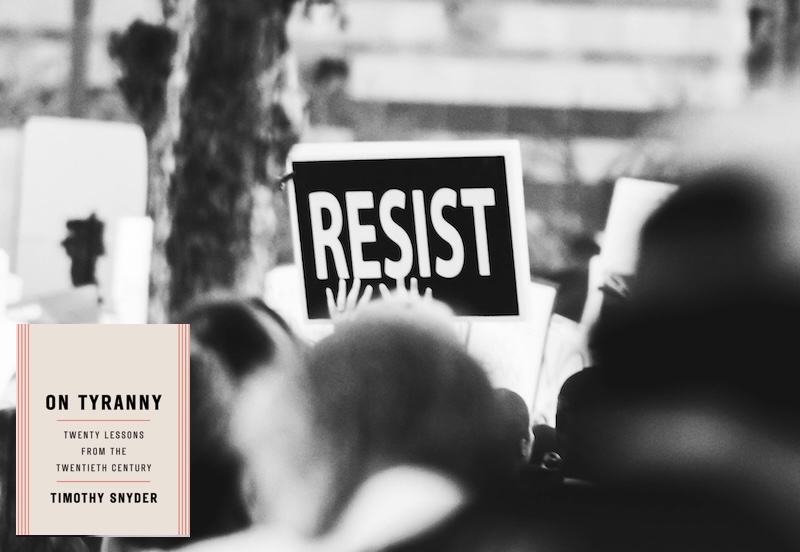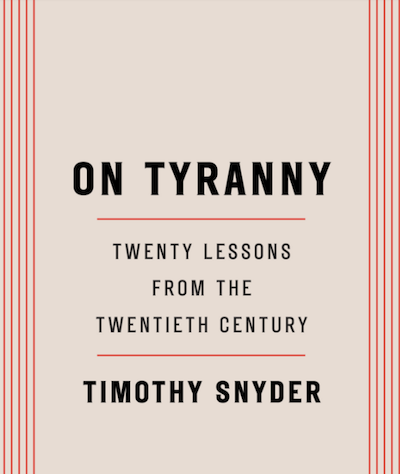If you missed the first post of this series, you’ll find it here:
Using Technology To Oppose Tyranny: Part 1
Timothy Snyder’s second lesson is:
Defend Institutions
Since this series is about using Technology To Oppose Tyranny, I thought this section would be a good place to demonstrate how you can use
AI, in this case the Deep Research model provided by Perplexity.ai, to assist you in figuring out what you
can do. Which institutions should you defend, if you want to oppose tyranny?
Here’s the prompt I gave Perplexity’s Deep Research to look for other institutions to defend:
The second of the 20 lessons in “On Tyranny” by Timothy Snyder is “Defend Institutions”. What would you say are 20 good institutions to defend, to help forestall tyranny? I think ProPublica might be one. I would like to create a list of institutions of different sorts that I can publish in an article
(Note that I may not have needed to mention ProPublica, but I’m used to providing examples, and that’s a very good one.)
The rest of this post is the unedited results returned by Perplexity.ai for that prompt.
Important:
I would normally use the results from AI as a starting point or background material for my own writing, but my purpose in this post is to demonstrate what you can do with today’s technology with a single prompt. This is an example.
Defending Democratic Institutions: Twenty Pillars Against Tyranny
In an era where democratic norms face unprecedented challenges, Timothy Snyder’s imperative to “defend institutions” emerges as a critical roadmap for preserving liberty. Drawing from historical precedents and contemporary struggles, this report identifies twenty institutions across diverse sectors that serve as bulwarks against authoritarianism. Their defense is not merely an act of preservation but an active commitment to the principles of accountability, transparency, and civic participation that underpin democratic governance.
Legal and Judicial Institutions
Independent Judiciary Systems
Courts, from the U.S. Supreme Court to state and municipal benches, form the backbone of the rule of law. They interpret legislation, check executive overreach, and safeguard constitutional rights. Snyder emphasizes that institutions like these “do not protect themselves” and require public vigilance to resist political manipulation. The erosion of judicial independence—seen in efforts to pack courts or undermine their authority—directly threatens democratic stability.
Bar Associations and Legal Ethics Bodies
Organizations like the American Bar Association enforce professional standards and advocate for judicial integrity. By holding lawyers and judges accountable to ethical codes, they prevent the legal system from becoming a tool of authoritarian agendas. Snyder’s call to “remember professional ethics” underscores their role in maintaining trust in legal processes.
Public Defender Offices
Ensuring equitable access to legal representation is fundamental to a just society. Public defenders protect marginalized communities from systemic oppression, embodying Snyder’s principle that institutions must serve all citizens, not just the powerful.
Investigative Journalism Outlets
ProPublica, The Guardian U.S., and local newspapers expose corruption, hold power accountable, and combat disinformation. Snyder warns that authoritarian regimes target independent media first, as seen in Hungary’s media capture. Defending these outlets ensures a well-informed public capable of resisting manipulation.
Public Broadcasting Networks
Entities like NPR and PBS provide nonpartisan news, countering the fragmentation caused by partisan media. Their educational programming fosters civic literacy, aligning with Snyder’s lesson to “believe in truth”.
Digital Rights Organizations
The Electronic Frontier Foundation (EFF) fights for free expression online, resisting surveillance and censorship. In an age where disinformation spreads rapidly, their work is vital to maintaining open discourse.
Civic and Advocacy Organizations
Civil Liberties Unions
The ACLU and NAACP Legal Defense Fund challenge discriminatory policies and protect minority rights. Their litigation and advocacy reflect Snyder’s admonition to “be kind in our language” while defending equality.
Voting Rights Groups
Organizations like the Brennan Center and Fair Fight Action combat voter suppression and gerrymandering. By ensuring free and fair elections, they uphold the foundational democratic principle of popular sovereignty.
Transparency Watchdogs
OpenSecrets and Transparency International track political spending and corruption, demystifying the influence of money in politics. Their efforts align with Snyder’s plea to “investigate” power structures.
Labor and Economic Institutions
Labor Unions
Unions like the AFL-CIO advocate for workers’ rights, countering economic exploitation and fostering collective bargaining power. Snyder highlights labor movements as historical counterweights to authoritarian co-optation.
Worker-Owned Cooperatives
By democratizing workplace governance, cooperatives model economic equity and resilience. They exemplify Snyder’s vision of institutions that empower citizens beyond electoral politics.
Governmental and Electoral Bodies
Election Administration Agencies
Bodies like the Election Assistance Commission ensure voting systems are secure and accessible. Their defense is critical to preventing the “big lie” tactics that erode trust in democratic outcomes.
Ethics Oversight Offices
The Office of Government Ethics enforces accountability among public officials, resisting conflicts of interest and corruption. Snyder stresses that ethical governance is inseparable from the rule of law.
Educational and Cultural Institutions
Universities and Research Centers
Academic institutions foster critical thinking and civic education. The Democracy Initiative at the University of Virginia, for example, studies democratic erosion and trains future leaders.
Public Libraries
Libraries provide free access to information, serving as community hubs for education and dialogue. Their role in combating misinformation aligns with Snyder’s emphasis on truth as a democratic pillar.
Historical Archives
The National Archives preserves governmental records, ensuring transparency and historical accountability. Protecting such institutions counters authoritarian attempts to rewrite history.
International and Grassroots Networks
Global Democracy Coalitions
The Global Democracy Coalition unites over 140 organizations worldwide to counter authoritarianism. Snyder’s transnational perspective underscores the interconnectedness of democratic struggles.
Groups like the Industrial Areas Foundation mobilize grassroots activism, empowering marginalized voices. Their work embodies Snyder’s call to “take responsibility for the face of the world”.
Interfaith Alliances
Organizations like the Interfaith Alliance bridge religious divides, promoting pluralism and resisting theocratic agendas. Their efforts reflect Snyder’s plea for solidarity across differences.
Conclusion
Defending institutions is not a passive act but a dynamic engagement with the mechanisms that sustain democracy. From courts to newsrooms, labor unions to libraries, each institution listed here represents a thread in the fabric of self-governance. As Snyder warns, their fall is sequential and irreversible without proactive stewardship. By fortifying these twenty pillars, citizens can resist tyranny’s allure and reaffirm the collective responsibility at democracy’s core. The task is urgent, but the tools—rooted in history and renewed by civic courage—are at hand.




Use the share icon here if you liked it.
Thanks!